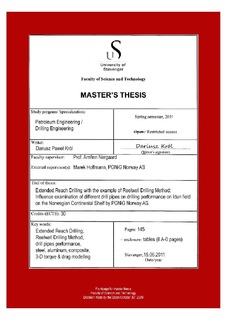| dc.description.abstract | Horizontal or extended reach drilling is incredibly fast growing technology. Although in some areas of the world ERD is still novelty, most of oil companies have been using the technology reliably and successfully for dozens of years. And those companies want to improve well-worn solutions to obtain better performance, thereby reducing costs.
One of the main aspects that affects drilling performance and efficiency is adequate choice of drill pipes.
The paper describes way of drill pipes’ selection that is based on detailed analyses and calculations of such factors as:
a) fatigue resistance & wear phenomenon
b) drag & torque issues
c) torsion strength, buckling tendencies
d) BHA design
For each of the factors shown above, appropriate analyze model has been chosen to simplify the train. Moreover all of the calculations required were presented and explained in accessible way. Additional comments were run where needed.
Further, three different drill pipes have been selected to show possible ways of improvement. They differ with material (S-135 steel DP, Aluminum DP, Composite DP), with size (4 ½”, 5”, 5 ½” for steel and aluminum pipes, 3 3/8”, 5 ½” for composite pipes) as well as with different mechanical properties.
To cast light on technical feasibility, theoretical assumptions regarding wellbore design, wellbore and environmental conditions have been made. Data such as drill pattern, drill design, wellbore size(s), TVD, MD and temperature had to be assumed. They are specified, not to have them wrong, with the real data provided by Dolphin Drilling Company.
Furthermore, all of the results are briefly presented and detailed comparison has been made. The best solution, for the given wellbore conditions, has been chosen and shown with close comment and justification.
Finally, alternative solutions have been presented as well. Possibility of the results improvement with additional equipment has been explained. | no_NO |
